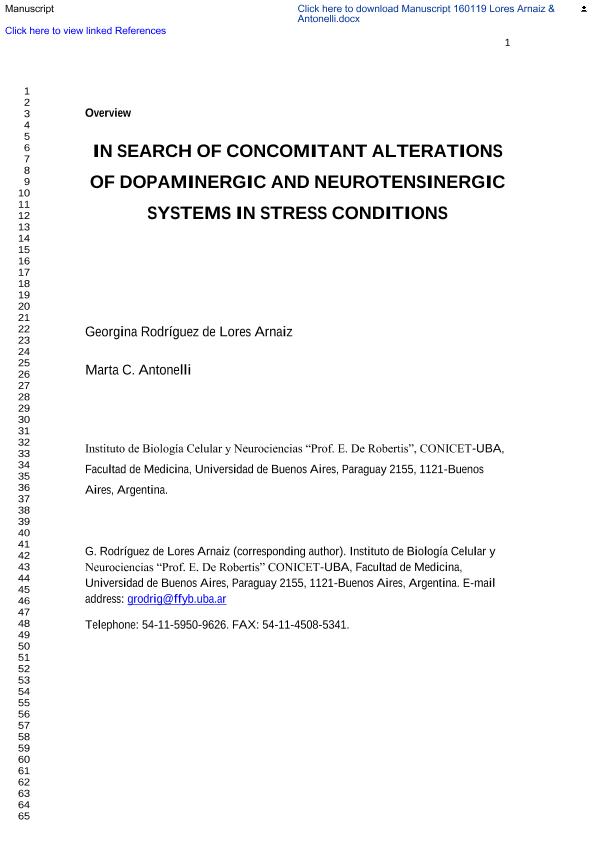Mostrar el registro sencillo del ítem
dc.contributor.author
Rodriguez, Georgina Emma

dc.contributor.author
Antonelli, Marta Cristina

dc.date.available
2018-03-14T18:57:03Z
dc.date.issued
2016-02
dc.identifier.citation
Rodriguez, Georgina Emma; Antonelli, Marta Cristina; In search of concomitant alterations of dopaminergic and neurotensinergic systems in stress conditions; Springer/Plenum Publishers; Neurochemical Research; 41; 1-2; 2-2016; 423-430
dc.identifier.issn
0364-3190
dc.identifier.uri
http://hdl.handle.net/11336/38761
dc.description.abstract
The aim of the present article is to review experimental evidence which suggest joint involvement of both the dopaminergic and neurotensinergic systems in stress conditions. At present, the concept of stress refers to an environmental demand exceeding the normal regulatory ability of an organism, particularly during unpredictable and uncontrollable situations. Chronic stress yields devastating effects including cognitive and working memory dysfunctions, for which neurotransmission mediated by the catecholamines dopamine and noradrenaline is crucial. Catecholamine synthesis depends on the rate-limiting enzyme, tyrosine hydroxylase, whose expression is associated with working memory and the response to chronic stress. Neurotensin is a tridecapeptide widely distributed in the nervous system, at both central and peripheral levels, which behaves as a neurotransmitter or neuromodulator. It mediates diverse biological actions including reward, locomotion, pain modulation and stress. Neurotensin and its high affinity NTS1 receptor are densely localized in areas that process emotion (amygdala nucleus), cognition (such as hippocampal nuclei and cortical areas) and the response to stress (hypothalamic nucleus). Experimental evidence indicates a crosstalk between the dopaminergic and the neurotensinergic systems either from an anatomical or a biochemical point of view. It is suggested that a concomitant alteration of dopaminergic and neurotensinergic systems takes place in diverse stress conditions.
dc.format
application/pdf
dc.language.iso
eng
dc.publisher
Springer/Plenum Publishers

dc.rights
info:eu-repo/semantics/openAccess
dc.rights.uri
https://creativecommons.org/licenses/by-nc-sa/2.5/ar/
dc.subject
Dopamine
dc.subject
Dopaminergic D2 Receptor
dc.subject
Dopaminergic System
dc.subject
Neurotensin
dc.subject
Neurotensinergic System
dc.subject
Nts1 Receptor
dc.subject
Stress
dc.subject
Tyrosine Hydroxylase
dc.subject.classification
Neurociencias

dc.subject.classification
Medicina Básica

dc.subject.classification
CIENCIAS MÉDICAS Y DE LA SALUD

dc.title
In search of concomitant alterations of dopaminergic and neurotensinergic systems in stress conditions
dc.type
info:eu-repo/semantics/article
dc.type
info:ar-repo/semantics/artículo
dc.type
info:eu-repo/semantics/publishedVersion
dc.date.updated
2018-03-14T17:06:13Z
dc.identifier.eissn
1573-6903
dc.journal.volume
41
dc.journal.number
1-2
dc.journal.pagination
423-430
dc.journal.pais
Estados Unidos

dc.description.fil
Fil: Rodriguez, Georgina Emma. Consejo Nacional de Investigaciones Científicas y Técnicas. Oficina de Coordinación Administrativa Houssay. Instituto de Biología Celular y Neurociencia ; Argentina
dc.description.fil
Fil: Antonelli, Marta Cristina. Consejo Nacional de Investigaciones Científicas y Técnicas. Oficina de Coordinación Administrativa Houssay. Instituto de Biología Celular y Neurociencia ; Argentina
dc.journal.title
Neurochemical Research

dc.relation.alternativeid
info:eu-repo/semantics/altIdentifier/doi/http://dx.doi.org/10.1007/s11064-016-1849-5
dc.relation.alternativeid
info:eu-repo/semantics/altIdentifier/url/https://link.springer.com/article/10.1007%2Fs11064-016-1849-5
Archivos asociados
